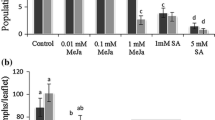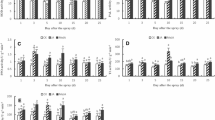Abstract
The effects were examined of plant-response signaling compounds, salicylic acid (SA) and methyl jasmonate (MeJA), on resistance to pill-bugs (Armadillidium vulgare) attack in lettuce plants. Foliar SA and MeJA applications were made at weekly intervals from the emergence of the plant until one week before harvesting. SA and MeJA induced detectable levels of hydrogen peroxide (H2O2) at least during 5 days post-application in these plants throughout their cultivation. On the whole, SA and MeJA in the concentrations and application scheme evaluated in this research did not significantly influence the dry and fresh weight matter of plants, or the chlorophyll and nitrate contents. In addition, both signal elicitors significantly diminished lettuce mortality due to pill-bugs, which was positively correlated with phenolics and flavonoids contents. Our results suggest that SA and MeJA, especially in low concentrations, should be further evaluated in lettuce production and priming resistance.


Similar content being viewed by others
References
Abu-Rayyan, A. B., Kharawish, H., & Al-Ismail, K. (2004). Nitrate content in lettuce (Lactuca sativa L.) heads in relation to plant spacing, nitrogen form and irrigation level. Journal of the Science of Food and Agriculture, 84, 931–936.
Ananieva, K., Ananiev, E. D., Mishev, K., Georgieva, K., Malbeck, J., Kamínek, M., et al. (2006). Methyl jasmonate is a more effective senescence-promoting factor in Cucurbita pepo (Zucchini) cotyledons when compared with darkness at the early stage of senescence. Journal of Plant Physiology, 164, 1179–1187.
Barrera-Pacheco, A., de Joaquín-Ramos, A. J., Torres-Pacheco, I., González-Chavira, M. M., Pérez-Pérez, M. C. I., Guevara-Olvera, L., et al. (2008). Analysis of transcriptional expression induced in Capsicum chinense BG-3821 under conditions of biotic and abiotic stress. Agrociencia, 42, 95–106.
Canacki, S. (2008). Effects of salicylic acid on fresh weight change, chlorophyll and protein amounts of radish (Raphanus sativus L.) seedlings. Journal of Biological Sciences, 8, 431–435.
Cardenas-Navarro, R., & Robin, A. P. (1999). Nitrate accumulation in plants: a role for water. Journal of Experimental Botany, 50, 613–624.
Chao, C., Xue-Qiang, Z., Yong-Guan, Z., Bin, L., Yi-Ping, T., & Zhen-Sheng, L. (2007). Regulation of the high-affinity nitrate transport system in wheat roots by exogenous abscisic acid and glutamine. Journal of Integrative Plant Biology, 49, 1719–1725.
Custers, J. H. H. V., Harrison, S. J., Sela-Buurlage, M. B., van Deventer, E., Lageweg, W., Howe, P. W., et al. (2004). Isolation and characterization of a class of carbohydrate oxidases from higher plants, with a role in active defence. The Plant Journal, 39, 147–160.
Du, Y., Poppy, G. M., Powell, W., Pickett, J. A., Wadhams, L. J., & Woodcock, C. M. (1998). Identification of semiochemicals released during aphid feeding that attracts parasitoid Aphidius ervi. Journal of Chemical Ecology, 24, 1355–1369.
Feregrino-Perez, A. A., Berumen, L. C., Garcia-Alcocer, G., Guevara-Gonzalez, R. G., Ramos-Gomez, M., Reynoso-Camacho, R., et al. (2008). Composition and chemopreventive effect of polysaccharides from common beans (Phaseolus vulgaris L.) on azoxymethane-induced colon cancer. Journal of Agricultural and Food Chemistry, 56, 8737–8744.
Gent, M. P. N. (2006). Modeling the effect of nutrient solutions composition and irradiance on accumulation of nitrate in hydroponic lettuce. Acta Horticulturae, 718, 469–476.
Glazebrook, J. (2001). Genes controlling expression of defense responses in Arabidopsis: 2001 status. Current Opinion in Plant Biology, 4, 301–308.
Jing-Feng, H., Bantroch, D. J., Greenwood, J. S., & Staswick, P. E. (1991). Methyl jasmonate treatment eliminates cell-specific expression of vegetative storage protein genes in soybean leaves. Plant Physiology, 97, 1512–1520.
Kessler, A., & Baldwin, I. T. (2002). Plant responses to insect herbivory: the emerging molecular analysis. Annual Review of Plant Biology, 53, 299–328.
Kim, H. J., Fonseca, J. M., Choi, J. H., & Kubota, C. (2007). Effect of methyl jasmonates on phenolic compounds and carotenoids of romaine lettuce (Lactuca sativa L.). Journal of Agricultural and Food Chemistry, 55, 10366–10372.
Kowalczyk-Jusko, A., & Koscik, B. (2002). Possible use of the chlorophyll meter (SPAD-502) for evaluating nitrogen nutrition of the Virginia tobacco. Electronic Journal Polish Agriculture University, 5, 1–5.
Kunkel, B. N., & Brooks, D. M. (2002). Cross talk between signaling pathways in pathogen defense. Current Opinion in Plant Biology, 5, 325–331.
Larqué-Saavedra, A., & Martin-Mex, R. (2007). Effects of salicylic acid on the bioproductivity of plants. In S. Hayat & A. Ahmad (Eds.), Salicylic acid—a plant hormone (pp. 15–23). Dordrecht, the Netherlands: Springer. Ch. 2.
Meuriot, F., Noquet, C., Avice, J. C., Volenec, J. J., & Cunningham, S. M. (2004). Methyl jasmonate alters N partitioning, N reserves accumulation and induces gene expression of a 32-kDa vegetative storage protein that possesses chitinase activity in Medicago sativa taproots. Physiologia Plantarum, 120, 113–123.
Moreira, X., Sampedro, L., & Zas, R. (2009). Defensive responses of Pinus pinaster seedlings to exogenous application of methyl jasmonate concentration effect and systemic response. Environmental and Experimental Botany, 67, 94–100.
Morisawa, J., Kim, C. S., Kashiwagi, T., Tebayashi, S., & Horiike, M. (2002). Repellents in the Japanese cedar, Cryptomeria japonica, against the pill-bug, Armadillidium vulgare. Bioscience, Biotechnology, and Biochemistry, 66, 2424–2428.
Ollerstam, O., & Larson, S. (2003). Salicylic acid mediates resistance in the willow Salix viminalis against the gall midge Dasineura marginemtorquens. Journal of Chemical Ecology, 29, 163–174.
Orsel, M., Filleur, S., Fraisier, V., & Daniel-Vedele, F. (2002). Nitrate transport in plants: which gene and which control? Journal of Experimental Botany, 53, 825–833.
Ozeretskovskaya, O. L., & Vasyukova, N. I. (2001). The use of elicitors for protection of cultured plants demands caution. Applied Biochemistry and Microbiology, 38, 277–279.
Park, Ch.-J., An, J.-M., Shin, Y.-Ch., Kim, K.-J., Lee, B.-J., & Paek, K.-H. (2004). Molecular characterization of pepper germin-like protein as the novel PR-16 family of pathogenesis-related proteins isolated during the resistance response to viral and bacterial infection. Planta, 219, 797–806.
Penninckx, I. A. M. A., Eggermont, K., Terras, F. R. G., Thomma, B. P. H. J., De Samblanx, G. W., Buchala, A., et al. (1996). Pathogen-induced systemic activation of a plant defensin gene in Arabidopsis follows a salicylic acid-independent pathway. The Plant Cell, 8, 2309–2323.
Ramert, B., Bugg, R. L., Clark, M. S., Werner, M. R., McGuinn, R. P., Poudel, D. D., et al. (2001). Influence of Lumbricus terrestris inoculation on green manure disappearance and the decomposer community in a walnut orchard. Soil Biology and Biochemistry, 33, 1509–1516.
Rodríguez-Delfín, A., Hoyos, M., & Chang, M. (2001). Soluciones nutritivas en hidroponia: formulación y preparación. Lima, Perú: CIHNM, UNALM.
Sainz-Rosas, H., & Echeverría, H. E. (1998). Relationship between readings of chlorophyll meter (Minolta SPAD 502) at different crop corn stages and grain yield. Revista de la Facultad de Agronomía, La Plata, 103, 37–44.
Salzman, R. A., Brady, J. A., Finlayson, S. A., Buchanan, C. D., Summer, E. J., Sun, F., et al. (2005). Transcriptional profiling of sorghum induced by methyl jasmonate, salicylic acid, and aminocyclopropane carboxylic acid reveals cooperative regulation and novel gene responses. Plant Physiology, 138, 352–368.
Seema, G., Srivastava, M. K., Srivastava, S., & Shrivastava, A. K. (2003). Effect of methyl jasmonate on sugarcane seedlings. Sugar Tech, 5, 189–191.
Singleton, V. L., Orthofer, R., & Lamuela-Raventos, R. M. (1999). Analysis of total phenols and other oxidation substrates and antioxidants by means of Folin-Ciocalteu reagent. Methods in Enzymology, 299, 152–178.
Staswick, P. E., & Howell, S. H. (1992). Methyl jasmonate inhibition of root growth and induction of a leaf protein are decreased in an Arabidopsis thaliana mutant. Proceedings of the National Academy of Sciences USA, 89, 6857–6840.
Thaler, J. S. (2002). Effect of jasmonate-induced plant responses on the natural enemies of herbivores. Journal of Animal Ecology, 71, 141–150.
Thomma, B. P. H. J., Eggermont, K., Penninckx, I. A., Mauch-Mani, B., Vogelsang, R., Cammue, B. P., et al. (1998). Separate jasmonate-dependent and salicylate-dependent defense-response pathways in Arabidopsis are essential for resistance to distinct microbial pathogens. Proceedings of the National Academy of Sciences USA, 95, 15107–15111.
Thomma, B. P. H. J., Penninckx, I. A. M. A., Broekaert, W. F., & Cammue, B. P. A. (2001). The complexity of disease signaling in Arabidopsis. Current Opinion in Immunology, 13, 63–68.
Thordal-Christensen, H., Zhang, Z., Wei, Y., & Collinge, D. B. (1997). Subcellular localization of H2O2 in plants: H2O2 accumulation in papillae and hypersensitive response during the barley–powdery mildew interaction. Plant Journal, 11, 1187–1194.
van Loon, L. C., Rep, M., & Pieterse, C. M. J. (2006). Significance of defense-related proteins in infected plants. Annual Review of Phytopathology, 44, 135–162.
Wang, Q., Chen, J., Stamps, R. H., & Li, Y. (2005). Correlation of visual quality grading and SPAD reading of green-leaved foliage plants. Journal of Plant Nutrition, 28, 1215–1225.
Wright, J. C., & O’Donnell, M. J. (1995). Water vapour absorption and ammonia volatilization: adaptations for terrestriality in isopods. In M. A. Alikhan (Ed.), Terrestrial isopods biology. Rotterdam, the Netherlands: A.A. Balkema.
Wu, J., Wang, L., & Baldwin, I. T. (2008). Methyl jasmonate-elicited herbivore resistance: does MeJA function as a signal without being hydrolyzed to JA? Planta, 227, 1161–1168.
Yildirim, E., Turan, M., & Guvenc, I. (2008). Effect of foliar salicylic acid applications on growth, chlorophyll, and mineral content of cucumber grown under salt stress. Journal of Plant Nutrition, 31, 593–612.
Ziadi, N., Brassard, M., Bélanger, G., Claessens, A., Tremblay, N., Cambouris, A. N., et al. (2008). Chlorophyll measurements and nitrogen nutrition index for the evaluation of corn nitrogen status. Agronomy Journal, 100, 1264–1273.
Zolfagharinasab, R., & Hadian, J. (2007). Influence of methyl jasmonate on inducing chilling tolerance in pomegranate fruits (Malas Save). Pakistan Journal of Biological Sciences, 10, 612–616.
Acknowledgments
The authors acknowledge the support by Fondo de Investigación de la Facultad de Ingeniería de la UAQ (FIFI)-2008 and 2009, Proyecto de Equipamiento del Laboratorio de Biosistemas 2008, SEP-CONACyT 2006, FOMIX-Qro 2008 and PROMEP/103.5/08/3320 for this research. Additionally, Nancy Tierranegra-García, P. Salinas-Soto acknowledges grant support by CONACyT and Facultad de Ingeniería UAQ, and Marcela Vargas-Hernández acknowledges grant support by CONACyT. Special thanks are extended to Adriana Medellín-Gómez and Silvia C. Stroet of the Translation Edition Office of UAQ for technical review of the English manuscript.
Author information
Authors and Affiliations
Corresponding author
Rights and permissions
About this article
Cite this article
Tierranegra-García, N., Salinas-Soto, P., Torres-Pacheco, I. et al. Effect of foliar salicylic acid and methyl jasmonate applications on protection against pill-bugs in lettuce plants (Lactuca sativa). Phytoparasitica 39, 137–144 (2011). https://doi.org/10.1007/s12600-011-0147-7
Received:
Accepted:
Published:
Issue Date:
DOI: https://doi.org/10.1007/s12600-011-0147-7




